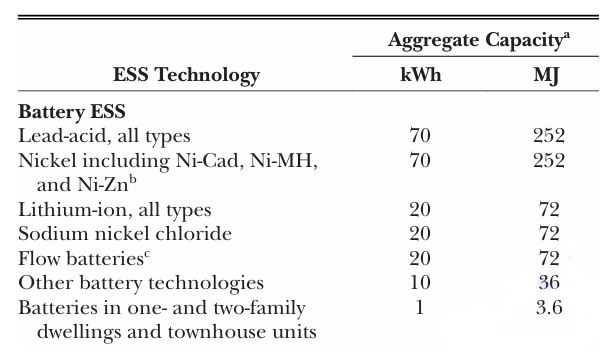HAZARD MITIGATION ANALYSIS (HMA)
HOME > OUR SERVICES > Hazard Mitigation Analysis (HMA)
HAZARD MITIGATION ANALYSIS (HMA)
Hazard Mitigation Analysis (HMA) is a systematic approach to identifying and reducing risks from potential hazards to protect communities, infrastructure, and the environment. The goal of HMA is to assess vulnerabilities and implement strategies that reduce the impacts of disasters such as floods, earthquakes, wildfires, and severe storms.
A hazard mitigation analysis shall be provided to the AHJ for review and approval when any of the following conditions are present:
- When technologies not specifically addressed in Table 1.3 are provided.
- More than one ESS technology is provided in a room or indoor area where adverse interaction between the technologies is possible.


Table 1.3 Threshold Quantities
Failure Mode Analysis
The analysis shall evaluate the consequences of the following failure modes and others deemed necessary by the AHJ:
(1) Thermal runaway condition in a single module, array, or unit
(2) Failure of an energy storage management system
(3) Failure of a required ventilation or exhaust system
(4) Failure of a required smoke detection, fire detection, fire suppression, or gas detection system
AHJ Approval for Hazard Mitigation Analysis of ESS Installations
The AHJ shall be permitted to approve the hazardous mitigation analysis as documentation of the safety of the ESS installation provided the consequences of the analysis demon strate the following:
- Fires will be contained within unoccupied ESS rooms for the minimum duration of the fire resistance rating
- Suitable deflagration protection is provided where required.
- ESS cabinets in occupied work centers allow occupants to safely evacuate in fire conditions
- Toxic and highly toxic gases released during normal charging, discharging, and operation will not exceed the PEL in the area where the ESS is contained.
- Toxic and highly toxic gases released during fires and other fault conditions will not reach concentrations in excess of immediately dangerous to life or health (IDLH) level in the building or adjacent means of egress routes during the time deemed necessary to evacuate from that area.
- Flammable gases released during charging, discharging, and normal operation will not exceed 25 percent of the LFL.
Construction, equipment, and systems that are required for the ESS to comply with the hazardous mitigation analysis shall be installed, tested, and maintained in accordance with this standard and the manufacturer’s instructions.
Let Our Consultant Help You
For any inquiries about our products or services or to request a quote, please don’t hesitate to contact us.
OUR SCOPE OF WORK
We provide you with the latest performance-based design solutions and engineering best practices while helping to determine applicable codes and standards. We comply with the national codes and standards, engineering best practices, performance-based consulting, and fire & life safety audit criteria. Our team also specializes in construction and system investigation during the lifecycle of a building and assists in designing a go-forward plan and helps manage the upgrade.
Fire Accessibility
AHJ Presentation & Plan Review
Cladding & Facace Evaluation
Commissioning
Catastrophic Response
Building Science
Fire Science
Evacuation Modeling
Protect Your Industrial Solution … Let Our Consultants Help You

We deliver international standard consultation service regarding fire safety & fire engineering.
Our Industries
– Flight Industries
– Commercial Buildings
– Educational Institutions
– Healthcare Buildings
– Hospitality & Entertainment
– Government & Military
Quick Links
– About Us
– Services
– News
– Request A Quote
– Privacy Policy
Get In Touch
A-09-05, Blok A, Office Radia, Persiaran Arked Bukit Jelutong, Seksyen U8, 40150 Shah Alam , Selangor
+603-50384859
+6017-2534211
Mon – Sat : 9am to 5pm
Copyright © 2019 Fesdes Sdn. Bhd. All Rights Reserved.
Co. Registration No. (1341647-A)